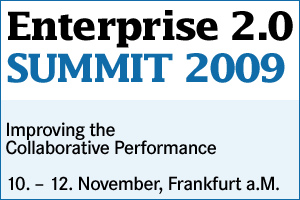 So, I am in the midst of collecting and reviewing some of my learnings from the E20SUMMIT last week – let me start with Wave (after focussing on the people of the E20SUMMIT in part 1 here), and we’ll see how many parts will follow. While this Wave at conferences evaluation may seem not really focussed on Enterprise 2.0 at first it offers some insights and learnings for the ongoing discussions of adoption and organizational readiness.
So, I am in the midst of collecting and reviewing some of my learnings from the E20SUMMIT last week – let me start with Wave (after focussing on the people of the E20SUMMIT in part 1 here), and we’ll see how many parts will follow. While this Wave at conferences evaluation may seem not really focussed on Enterprise 2.0 at first it offers some insights and learnings for the ongoing discussions of adoption and organizational readiness.
What do I mean? i think that during the SUMMIT both on-site and remote participants showed deep understanding of the usage of Wave for a conference backchannel – we’ve seen mature usage, ie. nobody misinterpreted the master- or the subwaves as a forum, as twitter substitute or as “facebook wall page”. People chose the channels that were most effective and they were professional at this.
Contrast this with the one wave that was filled during the BarCamp Hamburg (search for it with tag:bchh09), the two days after the SUMMIT – here the public wave evolved into a wild hodgepodge of close to 300 blips, together with added videos and stuff – all in all, an excellent example of what happens when geeks playfully explore a new thing 😉
 I assume that the difference is the result of provisioning of some pre-filled waves and an initial stucture – much like scaffolding a wiki this prepared and leveled the playing field, made it easier for new wavers to enter the E20SUMMIT wave space, find their way around and contribute in a meaningful way. That said, it’s probably an insight for our expectations regarding our employee’s readiness and competencies in using innovative collaboration infrastructures – even geeks on the cutting edge of the social web (like BarCampers typically are) aren’t grokking and mastering the new collaboration approaches easily. Scaffolding seems to be an essential element of enabling them (and their much less geeky colleagues). As such it’s a part of the “implementation effort” (in quoting signs because as we’ve learned at the SUMMIT implementation means different things to different people), I collect and systematize under the notions of “kennen-können-wollen-sollen”, ie. “know about it – master it – want it – be obliged (and ordered to)”. Scaffolding supports all four areas, and consequentially enabled the sustainable growth of the E20SUMMIT waves …
I assume that the difference is the result of provisioning of some pre-filled waves and an initial stucture – much like scaffolding a wiki this prepared and leveled the playing field, made it easier for new wavers to enter the E20SUMMIT wave space, find their way around and contribute in a meaningful way. That said, it’s probably an insight for our expectations regarding our employee’s readiness and competencies in using innovative collaboration infrastructures – even geeks on the cutting edge of the social web (like BarCampers typically are) aren’t grokking and mastering the new collaboration approaches easily. Scaffolding seems to be an essential element of enabling them (and their much less geeky colleagues). As such it’s a part of the “implementation effort” (in quoting signs because as we’ve learned at the SUMMIT implementation means different things to different people), I collect and systematize under the notions of “kennen-können-wollen-sollen”, ie. “know about it – master it – want it – be obliged (and ordered to)”. Scaffolding supports all four areas, and consequentially enabled the sustainable growth of the E20SUMMIT waves …
[…] zur Anwendung scheinen ein Baustein zum Erfolg zu sein. Martin Koser hat dieses Vorgehen in seinem Ergebnisbericht als “Scaffolding” beschrieben. “Scaffolding” bedeutet im übertragenen […]
[…] been looking back at the Wave use at the SUMMIT, at books and reports, and the social networking aspects of conferences, read people […]